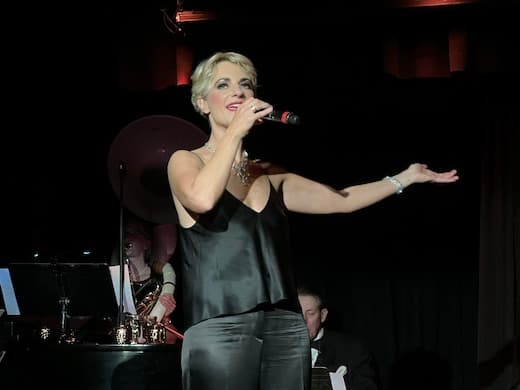New to Adrienne Haan? Start With Her Kurt Weill Show and Be Ready for Plenty More
Haan has always brought a remarkable energy, emotion, and palpable physicality to her interpretations of this music. Lately, she’s added a deeper and more nuanced understanding of what it all means.

For Kurt Weill (1900-1950), it was all about ships.
There were ships with sails of silk, with decks trimmed with gold, bearing the hopes and dreams of those who sailed upon them. Then there were ships that stormed into harbors with eight cannons loaded and rained down death and destruction upon any population that was unfortunate enough to be in their way.
Weill knew well both kinds of ships, and it was ships that carried him from his native country, where he had been persecuted as a “degenerate” — essentially for being Jewish — to the new world, where he would be embraced as a beloved musical auteur.
Adrienne Haan, the highly vivacious German singer and entertainer, opens her Weill show at the Triad with a juxtaposition of the composer’s two most famous musical vessels. They both are key songs in what are probably his two most successful works, the optimistic and soaring “My Ship” (from “Lady in the Dark,” 1941) and the sinister and brooding “Pirate Jenny” (from “Die Dreigroschenoper, The Threepenny Opera,” 1928).
Ms. Haan, who has been exploring this repertoire in New York for about a dozen years and around Europe for longer than that, has always brought a remarkable energy, emotion, and palpable physicality to her interpretations of this music. Lately, she’s balanced her extroverted side with a deeper and more nuanced understanding of what it all means.
After all my years of loving Weill’s music, she helped me noticed the metaphor of the ships, which is especially notable in that Weill only wrote music and two very different collaborator/lyricists, Bertolt Brecht and Ira Gershwin, were able to draw that out of him.
Ms. Haan is doing one more performance of her Kurt Weill show, on April 5 at the Triad, where she became a mainstay in the years before the pandemic and hopefully will be long after it. (Next month she returns to West 72nd Street with another show.) During the time of the lockdown, she emerged with two new projects, both of which are now being released as CDs.
She conceived “Tehorah” as a celebration of Liberation 75, the anniversary of the end of the Holocaust, and has been performing it in different cities in Europe; it was recorded and filmed in a concert hall in Bonn, Germany, and is also viewable in a 45-minute excerpt on YouTube.
“Tehorah” is a set of Jewish-themed songs, performed in Yiddish, Hebrew, and German, and is an informal but highly moving musical snapshot of European Jewish life from the height of Weimar to the founding of Israel.
The video opens on a fun and frivolous note with the satirical songs of Mischa Spoliansky, including “Allex Schwindel (It’s All a Swindle)” and “Ich bin ein Vamp (I am a Vamp),” which eventually leads to a deeply romantic interlude halfway through with Frederich Hollaender’s “Ich bin von Kopf bis Fuss auf Liebe eingestellt (Falling in Love Again).”
The performance is, appropriately, more serious than most of her shows — she usually finds a moment in each to sit on the laps of several gentlemen in the audience (try to get a seat on the aisle), and the Diplomatic String Quartet Berlin makes her soprano sound much more lush. Fraulein Haan concludes with just the right note of austerity and optimism with the prayer-like “Jerusalem of Gold.”
Ms. Haan’s other new album, “Rock Le Cabaret” (Un Hommage Rock a la Chanson Française), is somewhat of a departure. This isn’t the first time she’s done whole shows of the French chansons, the song books of Edith Piaf and Jaccques Brel, but now they’re rendered in surprising new arrangements that make use of heavy metal guitar and very aggressively jazzy tenor saxophone.
At the same time, it’s all very theatrical — overall it sounds more like a rock-ish work of musical theater, like “Hedwig” or “Spring Awakening.” I never thought I’d hear “La Vie en Rose” reinterpreted as an ’80s style power ballad, but I have to admit that if I have to listen to Leonard Cohen’s “Hallelujah” yet one more time, I’d just as soon hear it in French.
If you’re new to Ms. Haan’s oeuvre, the Kurt Weill show is the best place to start. It’s a sterling example of a one-woman performance (accompanied by a six-piece band directed by pianist Richard Danley and featuring Dan Levinson on clarinet and saxophones) that’s more of a fully realized, adroitly directed — thank you, Barry Kleinbort — theatrical experience than a nightclub show.
She works herself up to a tearful frenzy on “Surbaya Johnny” and then tries to recover during “Je Ne T’aime Pas” (one of Weill’s rarer French songs). Next she gets the crowd to join in loudly in search of the next whisky bar in “Alabama Song.”
As the two opening ship metaphor songs show, Ms. Haan has a prominent sense of symmetry; she began with “Pirate Jenny” and ended with Weill’s other homage to that same girl (or name, at least), “The Saga of Jenny.”
Instead of chopping off men’s heads, this Jenny messes up the lives of those around her by being noncommittal and indecisive. I’d prefer a good decapitation any day.
For an encore, it’s back to Broadway with “I’m a Stranger Here Myself.” It was sung coyly and kittenish by Mary Martin in “One Touch of Venus,” but Fraulein Haan belts it out in a highly confrontational fashion, planting her heels firmly on the stage floor as if to say, “J’Accuse,” which somehow serves to make it clear that this music is more relevant than ever.

